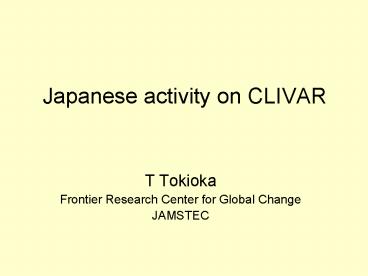Japanese activity on CLIVAR - PowerPoint PPT Presentation
1 / 15
Title:
Japanese activity on CLIVAR
Description:
Opened a 'Japanese version WCRP' web site to inform policymakers (of MEXT and ... Kyousei Integrated Synergetic System. Model of the Earth (KISSME) ... – PowerPoint PPT presentation
Number of Views:48
Avg rating:3.0/5.0
Title: Japanese activity on CLIVAR
1
Japanese activity on CLIVAR
- T Tokioka
- Frontier Research Center for Global Change
- JAMSTEC
2
- Opened a Japanese version WCRP web site to
inform policymakers (of MEXT and MOE) WCRP
research activities in Japan - http//www.jamstec.go.jp/frcgc/wcrp/wcrp/inde
x.html
3
The 2nd phase of Japanese global warming
projects
- (1) MEXT KAKUSHIN Project
- Using ES, which will be upgraded in mid-2008
(2alpha times faster) - Preparing new models to conduct AR5 runs in
FY 2009 - 3 principal teams a
- Each team consists of modellinguncertaintyim
pact assessment subgroups - Team 1 Long-term (PI Tatsushi Tokioka
FRCGC) - Team 2 Near-term (PI Masahide Kimoto,
CCSR/Univ. Tokyo) - Team 3 Hi-res time slice (PI Akio Kitoh,
MRI/JMA) - (2) MOE Feel the climate change project (PI
Akimasa Sumi, Univ. Tokyo Seita Emori NIES) - - Evaluation of AR4 AR5 models for misc.
climate phenomena (w/ metric) - - Impact/Uncertainty assessment
- - Public communication
- - Dynamical downscaling of climate scenarios
- - Downscale socio-economic scenarios
- (3) Data Integration and Analysis System (DIAS)
(PI Toshio Koike) - Aiming at GEOSS system of systems by
integrating multitudes of climate and environment
related data (incl. CMIP3)
4
The 2nd phase of Japanese global warming project
on the Earth Simulator(Kakushin Program
2007-2012)
- Team 1 Long-term (FRCGC/NIES/CCSR) Tokioka
- MIROC-kissme ESM (T42L801.0x1.4L44carbon
cycleaerosolschemistry) - NICAM global CSRM, EMIC for uncertainty
- physics ensemble
- detailed dyn veg
- crop yields, high tides
- Team 2 Near-term (CCSR/NIES/FRCGC) Kimoto
- MIROC AOGCM (T213L56AGCM1/4x1/6L44OGCMaerosols)
- Initialization w/ obs. 10-member ensemble
- Flood/drought risk assessment
- Regionally hi-res OGCM
- Team 3 Hi-res time-slice (MRI/JMA) Kitoh
- 20km AGCM 1km nested regional model near Japan
- Impact on hydrology, flood risk assessment,
Typhoons - Others
- Typhoons w/ regional model
- Oceanic turbulence parameterization
- Teams 1-3 all consist of Modelling/Uncertainty/I
mpact study components
5
Time line
ES upgrade
2006 2007 2008 2009
2010 2011 2012 2013
Model update - new cloud - new PBL - advanced
aerosol- chemistry - growing vegetation
Model development team
IPCC AR5
Runs for AR5
Analyses/drafts
Test run 20km model
Term of contract
Initialization/ uncertainty team
Develop initialization/ ensemble methodology
Ensemble initial- conditions
Verify impacts Advanced methodology
6
MJO event Dec. 2006
Miura et al.(2007)
2006?12?26?12UTC Initial 00UTC, 25 Dec.
MTSAT-1R TBB http//weather.is.kochi-u.ac.jp/
NICAM dx3.5km
7
Hovmoller along equator
MTSAT-1R TBB by T.Nakazawa
Miura et al. (2007)
NICAM dx7km OLR
8
- (others)
- MISMO---obs. project in the equatorial eastern
Indian ocean - HARIMAU---obs. project in the maritime continent
- MAHASURI---Japanese AA monsoon study
9
Kyousei Integrated Synergetic System Model of
the Earth (KISSME)
10
Near-term prediction
110km mesh model
- A near-term prediction up to 2030 with a
high-resolution coupled AOGCM - 60km Atmos 20x30km Ocean
- updated cloud PDF scheme, PBL, etc
- advanced aerosol/chemistry
- Estimate of uncertainty due to initial conditions
- 10(?)-member ensemble
- For impact applications
- water risk assessment system
- impacts on marine ecosystems
- etc.
- Test run w/ 20km AOGCM (in 2011)
60km mesh model
5-min topography
11
Extreme event projection with very-high
resolution atmospheric models
MRI / JMA / AESTO
High-resolution global atmospheric model
Regional cloud resolving model by nesting
Atmosphere-Ocean model
180km mesh
20km mesh
5km 1km mesh
Predicted SST
Atmosphere
Atmosphere
Boundary condition
SST
SST
Ocean
Boundary condition
Future
100-50km mesh
Near Future
Present
SST
11
SSTSea Surface Temperature
Year
1979-2003
2075-2099
2015-2039
12
S-5 Integrated Research on Climate Change
Scenarios to Increase Public Awareness and
Contribute to the Policy Process (MOE Feel the
climate change project)
Climate Change Predictions
Socio-Economic Scenarios
Theme 1(HQ)
Theme 2
Uncertainty Assessment
Theme 4
Evaluation of model performance for individual
phenomena for interacting multiple phenomena
Model Evaluation Metrics
Downscale Socio-Economic Scenarios Emission
Land-use Scenarios
Probabilistic Climate Scenarios
Impact Assessment
Theme 3
Downscale Climate Scenarios
Downscaled Scenarios
Future Climate Images
Spatially Explicit Socio-Economic, Emission
Land-use Scenarios
Communication
Intuitive Communication
User Needs
Collaboration
MoE GERF S-3 (Mitigation) S-4 (Impact)
MEXT Kakushin Programme (Prediction)
Decision Makers/General Public
- Provide the best science to stakeholders as a
basis for decision making. - Motivate public to act based on accurate science.
- Contribute to international scientific community
through IPCC, etc.
13
Data Integration and Analysis System (DIAS)
14
Global effects of seeds migration rate in a
changing world (Method)
CO2
500 yrs spinup with preindustrial climate
Precipitation
(IPCC IS92a Senario)
Simulation until AD 2100 with transient climate
(projected by HADCM2 CL, see figures)
Temperature
Sunshine hour
Another 100 yrs simulation with no further change
in climate (to examine inertia responses of
vegetation)
About seed migration scenarios
Fraction inside PFTs of newly established trees
are in proportion to the existing biomass of each
woody PFTs at the grid
Fraction outside all woody PFTs that can
establish at the given environment have same
possibility to establish
15
Global effects of seed-migration rate in a
changing world (Result)
Under slow seed-migration, vegetation cannot
follow climatic change, resulting in narrow
forest area
Global biomass (Pg C)
Rapid seed-migration
Slow seed-migration
2000
Global NPP (Pg C Yr-1)
2100
2100100
Both of global biomass and global NPP were lower
for slow seed-migration than for rapid
seed-migration































